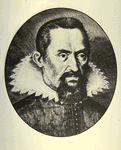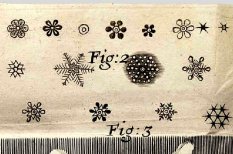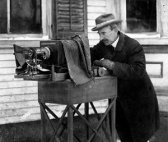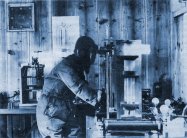|
|
Historic
Snowflakes
... Early observations and studies of snow crystals ... |
|
Many scientists throughout history
have pondered the mysteries of snow crystals -- what they are, where they come from, and
why they are shaped the way they are. Here are some highlights in the study of
snowflakes and snow crystals.
|
| 1611
-- Johannes Kepler |
 In 1611
Johannes Kepler published a short treatise On the Six-Cornered
Snowflake, [1] which was the first scientific reference to snow crystals. Kepler
pondered the question of why snow crystals always exhibit a six-fold symmetry.
Although he doesn't refer to the atomistic viewpoint, Kepler does speculate that the
hexagonal close-packing of spheres may have something to do with the morphology of snow
crystals. Kepler was astute in recognizing that the genesis of crystalline symmetry
was an interesting scientific question, and he also realized that he did not have the
means to answer it. It would be 300 years before Kepler's question could finally be
answered, requiring the development of X-ray crystallography. In 1611
Johannes Kepler published a short treatise On the Six-Cornered
Snowflake, [1] which was the first scientific reference to snow crystals. Kepler
pondered the question of why snow crystals always exhibit a six-fold symmetry.
Although he doesn't refer to the atomistic viewpoint, Kepler does speculate that the
hexagonal close-packing of spheres may have something to do with the morphology of snow
crystals. Kepler was astute in recognizing that the genesis of crystalline symmetry
was an interesting scientific question, and he also realized that he did not have the
means to answer it. It would be 300 years before Kepler's question could finally be
answered, requiring the development of X-ray crystallography. |
| "Each single plant has a single
animating principle of its own, since each instance of a plant exists separately, and
there is no cause to wonder that each should be equipped with its own peculiar shape. But
to imagine an individual soul for each and any starlet of snow is utterly absurd, and
therefore the shapes of snowflakes are by no means to be deduced from the operation of
soul in the same way as with plants." -- Kepler, 1611 [1] |
|
| 1635 -- René Descartes |
 Philosopher and mathematician René Descartes was the first to pen a reasonably accurate
description of snow crystal morphologies, about as well as can be done with the naked
eye. These careful notes included observations of capped columns and 12-sided
snowflakes, both rather rare forms. [2]
Philosopher and mathematician René Descartes was the first to pen a reasonably accurate
description of snow crystal morphologies, about as well as can be done with the naked
eye. These careful notes included observations of capped columns and 12-sided
snowflakes, both rather rare forms. [2]"These
were little plates of ice, very flat, very polished, very transparent, about the thickness
of a sheet of rather thick paper...but so perfectly formed in hexagons, and of which the
six sides were so straight, and the six angles so equal, that it is impossible for men to
make anything so exact."
"I only had difficulty to imagine what could have
formed and made so exactly symmetrical these six teeth around each grain in the midst of
free air and during the agitation of a very strong wind, until I finally considered that
this wind had easily been able to carry some of these grains to the bottom or to the top
of some cloud, and hold them there, because they were rather small; and that there they
were obliged to arrange themselves in such a way that each was surrounded by six others in
the same plane, following the ordinary order of nature." -- Descartes,
1635 [2] |
|
| 1665
-- Robert Hooke |
 In 1665 Robert Hooke published a large volume entitled Micrographia, containing sketches of practically
everything Hooke could view with the latest invention of the day, the microscope. Included
in this volume are many snow crystal drawings, which for the first time revealed the
complexity and intricate symmetry of snow crystal structure. (Note that an excellent, yet
inexpensive, digital version of Micrographia can be purchased from Octavo.) In 1665 Robert Hooke published a large volume entitled Micrographia, containing sketches of practically
everything Hooke could view with the latest invention of the day, the microscope. Included
in this volume are many snow crystal drawings, which for the first time revealed the
complexity and intricate symmetry of snow crystal structure. (Note that an excellent, yet
inexpensive, digital version of Micrographia can be purchased from Octavo.)
|
|
| 1931
-- Wilson A. Bentley |
 Wilson Bentley (1865-1931) was an American farmer and snow crystal
photomicrographer, who during his lifetime captured some 5000 snow crystal images.
More than 2000 were published in 1931 in his famous book, Snow Crystals,
which remains in print to this day. Some images from Bentley's
collection can be seen at the W.A.Bentley
web site.
Wilson Bentley (1865-1931) was an American farmer and snow crystal
photomicrographer, who during his lifetime captured some 5000 snow crystal images.
More than 2000 were published in 1931 in his famous book, Snow Crystals,
which remains in print to this day. Some images from Bentley's
collection can be seen at the W.A.Bentley
web site.
|
|
| 1954
-- Ukichiro Nakaya |
 Ukichiro Nakaya was the first person to
perform a true systematic study of snow crystals, which resulted in a
giant leap in our understanding of how snow crystals form. Trained as a
nuclear physicist, Nakaya was appointed to a professorship in Hokkaido,
the North Island of Japan, in 1932, where there were no facilities for
nuclear research. Undaunted, Nakaya turned his attention to snow
crystals, which were locally very abundant. He then made a superb
series of very detailed observations of all types of frozen
precipitation, clearly identifying and cataloging all the major snow
crystal types. Unlike Bentley, Nakaya photographed the great
variety of snow crystal types, not just those that were the most
beautiful and symmetric. Ukichiro Nakaya was the first person to
perform a true systematic study of snow crystals, which resulted in a
giant leap in our understanding of how snow crystals form. Trained as a
nuclear physicist, Nakaya was appointed to a professorship in Hokkaido,
the North Island of Japan, in 1932, where there were no facilities for
nuclear research. Undaunted, Nakaya turned his attention to snow
crystals, which were locally very abundant. He then made a superb
series of very detailed observations of all types of frozen
precipitation, clearly identifying and cataloging all the major snow
crystal types. Unlike Bentley, Nakaya photographed the great
variety of snow crystal types, not just those that were the most
beautiful and symmetric.
Nakaya's real triumph, however, came from growing artificial snow crystals in
the laboratory under controlled conditions. From the study of these artificial snow
crystals Nakaya was able to describe the crystal morphology under different environmental
conditions, which provides an extremely important clue for understanding the physics of
snow crystal formation.
The bulk of Nakaya's work was published in 1954 in a beautiful book entitled Snow
Crystals: Natural and Artificial. Though long out of print, Nakaya's book
offers a superb look at a scientific investigation which begins with almost nothing, and
proceeds through systematic observation toward an accurate description of a fascinating
natural phenomenon.
|
|
[1] Johannes Kepler, The Six-Cornered
Snowflake, 1611; translated by L. L. Whyte, 1966 (Oxford Univ. Press).
[2] F. C. Frank, "Descartes' Observations on the Amsterdam Snowfalls of 4, 5,
6 and 9 February 1634," J. Glaciology 13, 535 (1974). |
|
